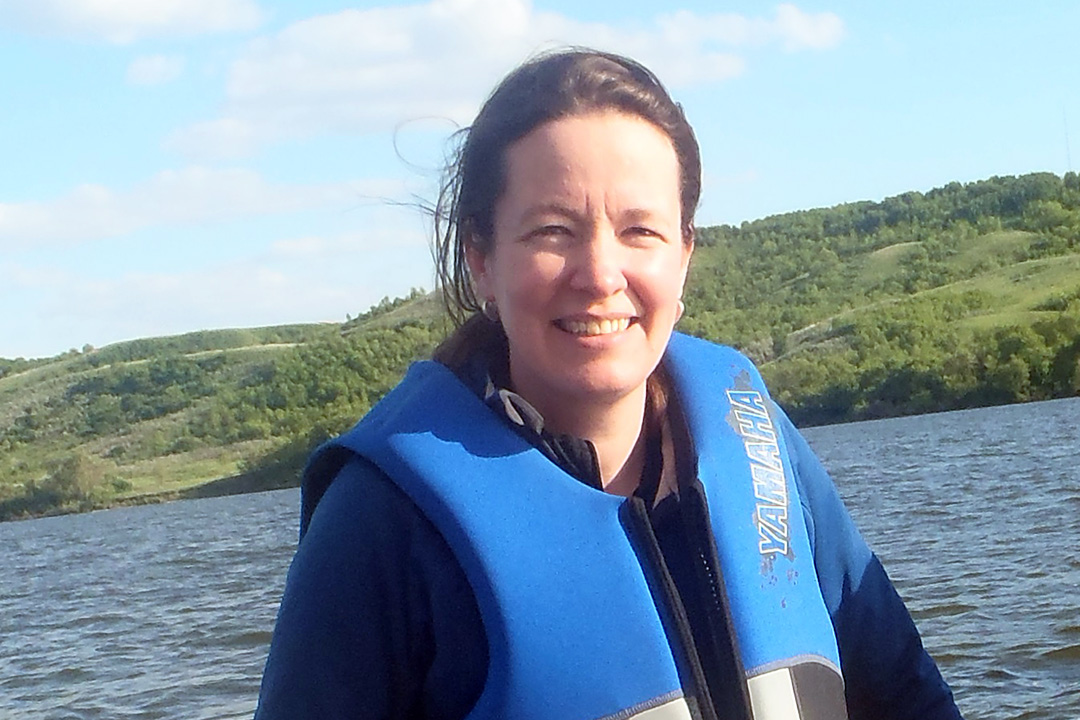
Health threat from blue-green blooms extends beyond single toxin: USask study
As blue-green algae proliferates around the world, a University of Saskatchewan (USask) researcher cautions that current municipal drinking water monitoring that focuses on a single toxin associated with the cyanobacteria blooms is likely to miss the true public health risks.
By USask Research Profile and Impact“We typically test only for microcystin in drinking water, but the toxicity risk is greater than that one toxin,” said Helen Baulch, an associate professor at USask’s School of Environment and Sustainability.
National drinking water guidelines require that treatment plants test only for microcystin, the most common toxin found in blue-green blooms. Although microcystin varieties are detected fairly frequently through treatment plant monitoring, their levels rarely exceed drinking water thresholds, she said.
But using some advanced analytical chemistry that goes beyond traditional testing, her team was surprised to find other toxins in some cyanobacteria-affected lakes, with a variety of modes of action and toxicity, among them a deadly variety known as anatoxin. The concentration of these toxins was low enough not to pose a current health risk, but their presence alone concerns Baulch.
Precaution is important, she said, because one cannot truly ascertain the toxin risk from a sample taken at one location at one time. The risk could be much higher or lower just a few metres away, or even a few hours later.
“I used to think blue-green blooms were a really interesting issue, and not one that would cause me to lose sleep at night. Now, my worry is growing,” said Baulch, lead investigator on a USask-led Global Water Futures project looking at developing forecasting tools and mitigation options for diverse bloom-affected lakes.
The frequency and severity of algal blooms and cyanobacteria are increasing across the globe due to higher nutrient loads—mainly phosphorus and nitrogen transported into lakes by runoff from agricultural land, and municipal effluent.
“Overlay this with changes in climate that are warming waters, and things will get a lot worse,” said Baulch, a member of USask’s Global Institute for Water Security.
A water treatment facility such as the plant at Buffalo Pound Lake that supplies drinking water to Regina and Moose Jaw has a large matrix of risks to manage, said Baulch, who has been working with the plant over the years to help meet some big challenges.
Microbial risks, such as the cryptosporidium parasite in drinking water that sickened nearly 7,000 people in North Battleford, are the primary concern of treatment plants. Microcystin and other toxins lower are on the priority list.
Buffalo Pound operators are proactive in fending off potential problems, and the plant will be upgraded or a new one built to meet the needs for another three or four decades, said Baulch.
She has some thoughts about what should be done: “We need further efforts to mitigate the bloom issue. We also need proactive water treatment in light of what we know about the toxins that can be present.”
Nutrient management is the most important step to mitigate blooms, but direct efforts to treat the ecosystem also are helpful, she said. Lake aeration—bubbling air through the water to add oxygen—is widely used in Canada to address bloom-related issues.
In some areas of Europe where cyanobacteria blooms are severe, direct treatment of lakes with alum and other chemicals has shown promise, Baulch said.
She is investigating what causes lakes to shift to cyanobacteria from beneficial algae such as diatoms, which play an integral role in a healthy lake ecology by producing oxygen and serving as food for other life forms. She is testing a hypothesis that low lake oxygen levels—caused by such factors as algae decomposing on lakebeds—trigger changes that cyanobacteria need to become dominant.
Hundreds of Saskatchewan lakes, many of them nutrient-rich shallow water bodies in the south, are potentially at risk, and some northern lakes are starting to show blooms as waters warm with climate change. In lakes where phosphorus has accumulated in sediment, the nutrient can be released into the water even decades later. This lag time before efforts to reduce nutrients show a benefit can be tough for policymakers, Baulch said, because citizens expect quick results from mitigation measures.
But a recently released study led by a post-doctoral fellow in Baulch’s lab showed that carefully controlling inputs (such as fertilizer) on agricultural land can rapidly draw down phosphorus concentration in soil and reduce the nutrient in runoff.
“We thought that there’d be a much longer lag time, so it’s promising that we can get a fast response in hotspots of nutrient transport,” she said.
Baulch is working with watershed groups and industry groups such as the Buffalo Pound water treatment plant to develop workable solutions, employing buoy-mounted high frequency water monitoring tools to gather data that help predict bloom formation.
“There’s a lot that we can do, and have been doing to mitigate problems,” said Baulch. “But with a changing climate adding to the challenge, this issue is urgent and deeply concerning.”
For more information, visit: https://gwf.usask.ca/science/projects/p3-formbloom.php
—30—
For more information, contact:
Jennifer Thoma
USask Media Relations
306-966-1851
jennifer.thoma@usask.ca
Article re-posted on .
View original article.

